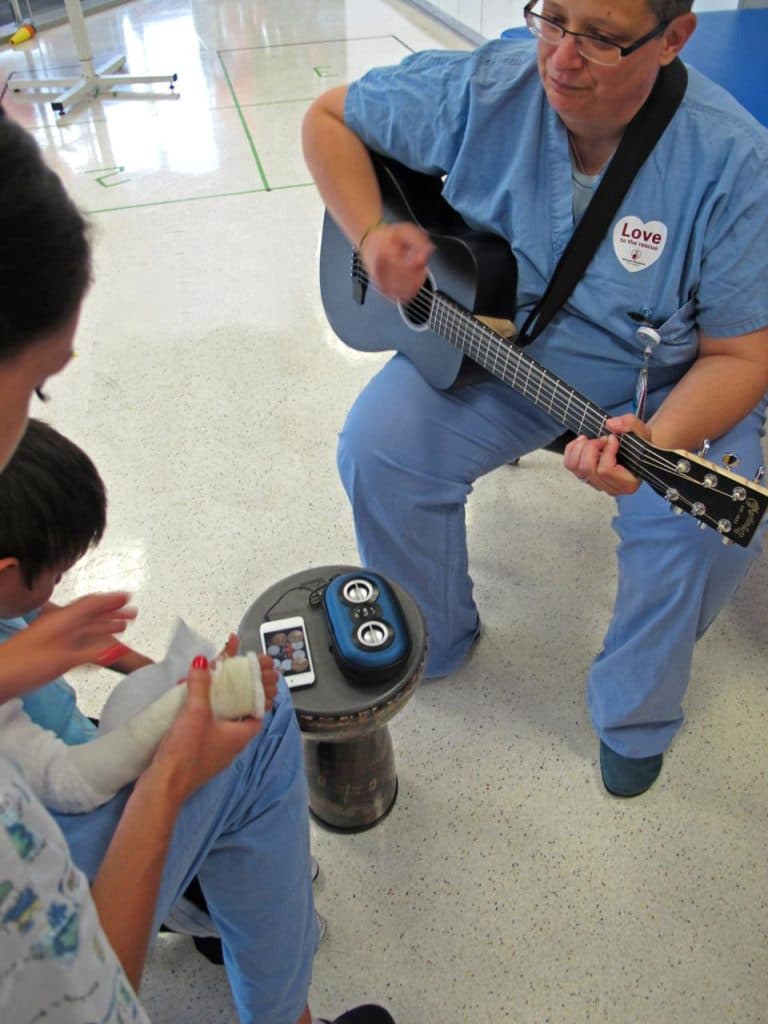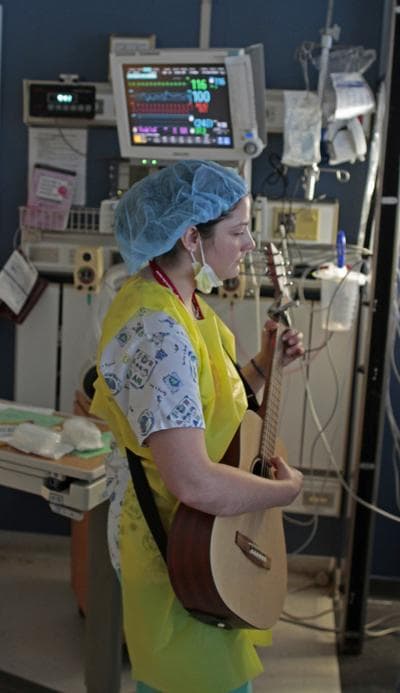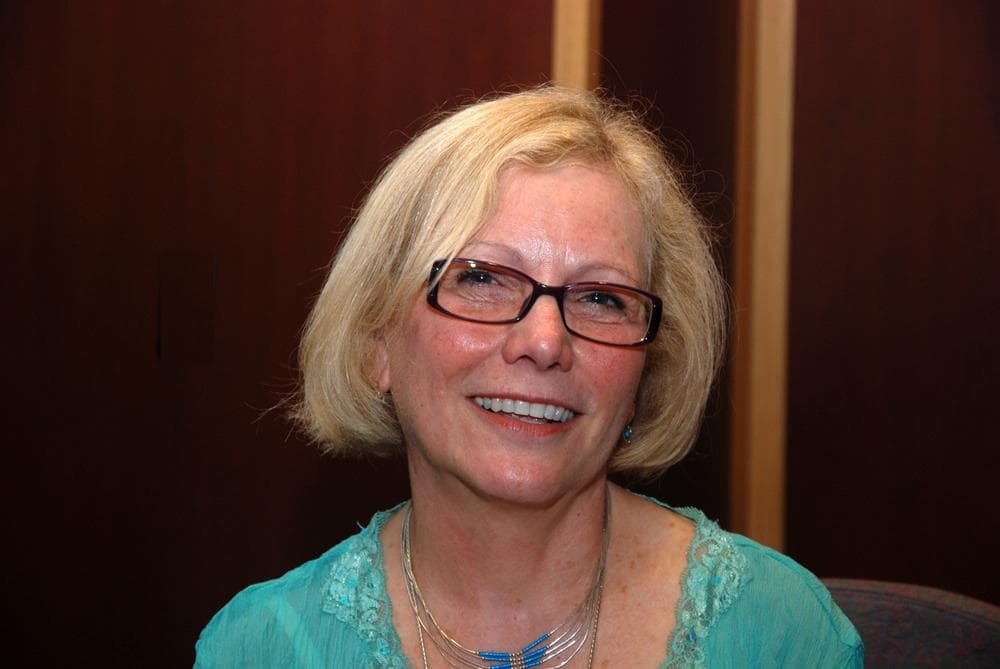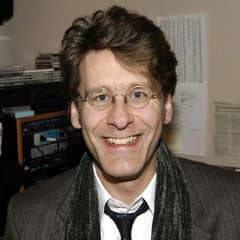Advertisement
Music Therapists Help Ease Treatment Of Children With Severe Burns
Shriners Hospital for Children in Boston is marking 10 years of its music therapy program. The program involves the clinical use of music in a medical setting to accomplish therapeutic goals such as pain management, anxiety reduction and physical rehabilitation. At Shriners in Boston, the focus is on burn care for children.
More Like A Game Than Therapy
It’s time for Estiven Romero’s physical therapy. He’s a quiet 4-year-old boy with a serious face and short, straight black hair. As an occupational therapist carefully removes a cast that keeps his elbow extended, music therapist Annette Whitehead-Pleaux sings to Estiven and encourages him to play along on an iPod touch.

Whitehead-Pleaux begins strumming on the guitar while Estiven taps the iPod. He's not quite in time with the music, but he's more interested in the iPod and the music than he is with the occupational therapist, who is carefully removing the cast on his arm. Whitehead-Pleaux sings a song using his name: "Estiven, mi amigo."
Estiven’s right arm and torso are mottled with red and white scar tissue. He was burned by scalding water about a year ago in his native country, Honduras. (Shriners hospitals provide care for free and take patients from all over the world.) Estiven is still working on getting full range of motion in his arm and gaining strength back in his wrist. That's why Whitehead-Pleaux, in her limited Spanish, asks Estiven if he wants to bang on a drum in the next song. She begins singing "La Bamba."
As part of his physical therapy, he must stretch his burned arm. To make him reach, Whitehead-Pleaux holds the drum high and encourages him to hit it hard. It's more like a game than therapy.
Advertisement
"Higher, bigger," she says.
All of this activity diverts his brain’s attention away from the pain. But research shows music therapy is more than a distraction. Whitehead-Pleaux says brain studies show that music lowers the perception of pain.
"When people just listen to music and have a peak experience in music, the amygdala totally shuts down and there’s no activity on it," she says. "We’re not silly to think that music therapists in a painful situation will cause a peak experience, but if we can get someone actively engaged in listening the hope and the theory is that we reduce the activity on the amygdala and thus, reduce the amount of anxiety and negative emotion the person may be feeling."
And Whitehead-Pleaux adjusts her songs depending on what’s happening. When Estiven gets his arm stretched to a new position for his cast, he starts to cry and she softens her playing. The hour-long session passes quickly, and Estiven leaves the hospital with a re-positioned cast.
Shriners Hospital in Boston has two full-time music therapists, more than any other area hospital that treats children. The therapists use music at many different types of appointments, even during the most painful ones such as dressing changes.
'It’s An Emotional Roller-Coaster'

Music therapist Stephanie Clark is softly playing "Twinkle, Twinkle, Little Star" on the guitar and singing beside the bed of 3-year-old Angelina Toots.
"My goal today is to go in there and just help support her through the music, help change the environment to be a more comfortable, familiar environment and just be present with her and respond to her responses, whatever they may be," Clark says.
Almost every part of Angelina’s body is burned except for her sweet face and soft blonde curls. According to her father, William Toots, the family was at home in Connecticut when it happened.
"We were outside cooking out," Toots explains. "She ran in to go to the bathroom. She had some ruffles on her dress that accidentally hit the candle that spread over her dress and burned her really bad."
As a team of nurses changes Angelina's dressing, her father sits nearby, alongside her mother Catherine.
"It’s an emotional roller-coaster," Catherine Toots says. "We have our good days and our bad days just like Angelina does. When she hurts, we hurt, so it’s hard to be strong for her."
Angelina's father adds: "Knowing how much Angie loves music to begin with — she loves to go to sleep with the music on and radio on and she loves to dance and play around all the time — having the musical therapist here with her is probably the best thing for her in this point in time for her mind and her body."
Angelina is heavily sedated; music therapy doesn’t take the place of painkillers. But Carrie Jones, a nurse on Shriners' acute care unit, says music has many medical benefits, especially during the first weeks of care when wounds need to be redressed daily.
"We’ve seen a child with heart rates in the 180s and they’ll start playing or start singing and their heart rate slowly drops, their anxiety decreases, and it really helps them kind of get through, however long the procedure may be," Jones says. "They are amazingly instrumental to the process."
Mary Jo Barza, the director of therapeutic services at Shriners, agrees.

"One of the advantages that we didn't anticipate is that the nurses and therapists who are taking care of the patients will often say the music therapy brings their level of anxiety down and then of course when they are less anxious that carries over to the child and the parent," Barza says.
Turning Lost Time Into A Gain
And music therapists often develop long relationships with their young patients. Burns can take years to heal. As the child grows, the scarred and grafted skin doesn't stretch like normal skin, so they need more surgeries. That sometimes allows Whitehead-Pleaux enough time to teach the children to play an instrument, which helps with their self-esteem.
"Especially in a time when they’ve lost body function or they’ve lost a limb and they lost all this time with family and friends that if they come away from the hospital with something they’ve gained as well, I think that’s a huge ego booster," Whitehead-Pleaux says.
On this day she’s giving a guitar lesson to Jesus Rocano, an 18-year-old from Ecuador. She's been helping him for two years. Jesus is in a wheelchair, and under a blanket, his legs seem to melt away below the knee. He lost both lower limbs in an electrocution.
Whitehead-Pleaux calls out the chords as she sings so Jesus can play along with her. He looks confident with his guitar. He practices at home and continues his lessons when he comes back for the now-occasional appointments at Shriners. Jesus says it's hard to put into words what learning the guitar has meant to him, but he says he just knows that he likes it.
That’s the goal of music therapy — to ease a difficult time.
This program aired on October 9, 2012.
